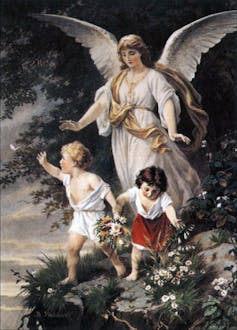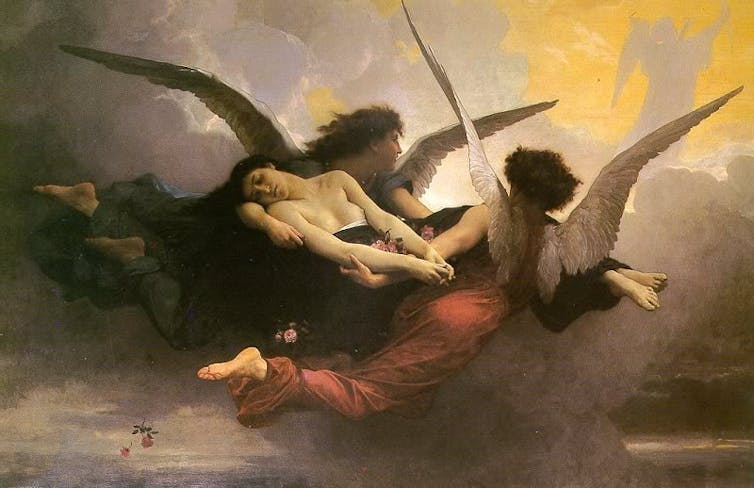
Within Christianity, the question of the nature of human identity has been a messy and complex one.
For its first 200 years, Christianity adopted the Hebrew understanding of human identity as a unity of physical and spiritual parts, not divided into body and soul. There is no concept of the immortal soul in the Hebrew Old Testament nor in the Christian New Testament.
But in the late second century, Christianity happily absorbed the doctrine of the soul from the Greek Platonic tradition. From that time on, humans were thought of as hybrids – consisting of an immortal soul united with a mortal body.
How body and soul related to each other has been, in Western thought, a never ending matter for philosophical speculation.
Clearly, bodies were gendered male or female. But souls were not. They were, after all, non-corporeal, spiritual entities. And thus, there was nothing to differentiate the sexes. As Cyril, Bishop of Jerusalem (c. 315-86), put it,
the soul is immortal, and all souls are alike both of men and women; for only the members of the body are distinguishable.
In this way souls were rather like angels who were also, as spiritual creatures, non-gendered.
Angels, however, could assume virtual, ethereal bodies. But, even then, they were generally imagined as assuming male bodies. For this reason, angels have traditionally had men’s names – Gabriel, Michael, Raphael.
Read more: Friday essay: what do the 5 great religions say about the existence of the soul?
Then, in the 19th century in the Romantic movement especially, angels became less attached to the Christian tradition. They shifted from supporting kings and enabling sorcerers to benign beings whose activities remained in heaven. They were feminised and ethereal, less based on their representation in the Bible and more on classical Greek sources, They began to assume female, even androgynous, bodies. From then on, women (but no longer men) could be and would be called (metaphorically, at least) “angels”.

Generally speaking, the Christian tradition at that time held that, in life immediately after death, as immortal souls that had left our gendered mortal bodies, we would no longer be essentially male or female.
That said, souls had a kind of quasi-bodily nature – they were depicted as leaving the body, were spatially located in heaven, hell, or purgatory, and could experience rewards and punishments after death.
But the situation was complicated by the fact that we would be eventually re-united with our bodies when they arose from the dead on the Day of Judgement.
We would then go forward into eternity as non-gendered souls re-united with gendered bodies, and with all our imperfections removed.
Of course, the issue of gender in Christianity was further complicated by the statement in the book of Genesis that both men and women were made in the image of God. This was never (well, hardly ever) read as meaning that God had a physical body (either male or female). Rather, the image of God was located in the spiritual qualities of humans.
That said, there was a general belief that women were made less in the image of God than men. There was a key biblical precedent for this. Man “is the image and glory of God,” declared Saint Paul, “but the woman is the glory of the man”.
And the woman, he went on to say, was created for the man and not vice versa. So, while the Biblical texts were used, on occasions, to justify the least assertive of feminisms, they more often justified the most aggressive of misogynies.
Generally, up until the 18th century, female bodies were thought of theologically as a part of the male body as in the Genesis 2.22 account of Eve being made from a rib of Adam; or philosophically as in Aristotle’s dismissal of the female as a defective male.
The rise of biology
In the 18th and 19th centuries, when the idea of “gender” came to be dominated by the biology of sex, along with an increasing social differentiation between men and women, the “one-sex” model with the male as human “prototype” (with a non-gendered soul) came to be dominated by the “two-sex” model with which we are familiar.
In this modern version, male and female bodies are seen as fundamentally different. Biology came to dominate theology and philosophy.
As biological understandings of human identity came to dominate, so the traditional understanding of the non-gendered soul began to disappear.

Life immediately after death came to be thought of as occurring in spiritual bodies that matched our gendered physical bodies as they had been at their best in this life. We would become rather like angels.
By the middle of the 19th century, the idea of the afterlife as an eternity spent worshipping God was replaced in popular culture by an eternity where we would spend time with former friends, families, and even pets. Heaven became a place of companionship, of amiable conversation, of spiritual progress, and intellectual development.
So, the modern heaven is a secular one in which God, and for that matter souls, play little role. It is no longer one of “embodied” souls but of “spiritual” bodies, enjoying for eternity the best of this world in the next. And, in this vision of the afterlife, we essentially and eternally are gendered in spiritual bodies in a way that reflects our physical bodies in this life, whatever form that may have taken.
Read more: Friday essay: what might heaven be like?
All this should remind us that our understanding of what counts as male and female is a very recent one. Rather, in the history of Western thought, notions of human identity have been much more fluid and unstable than we currently realise.
In the history of the idea of “human identity”, the meanings of “man” and “woman” have been as much socially constructed as biologically determined.
Granted the weird and wonderful history of the debate around human identity within Western civilisation, we would do well not to stake too much of a claim about the essence of the human as grounded in the modern biological understanding of male and female as binary opposites.
Philip C. Almond does not work for, consult, own shares in or receive funding from any company or organization that would benefit from this article, and has disclosed no relevant affiliations beyond their academic appointment.
This article was originally published on The Conversation. Read the original article.







